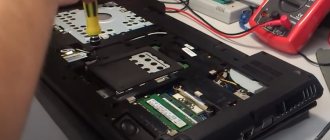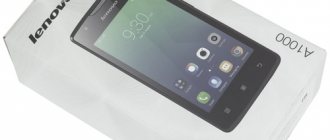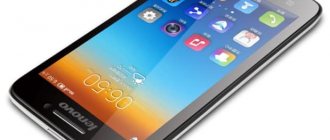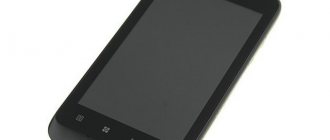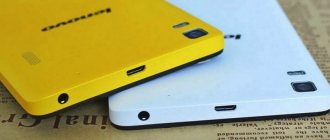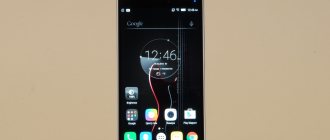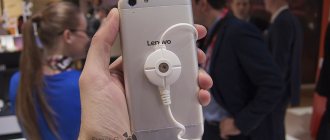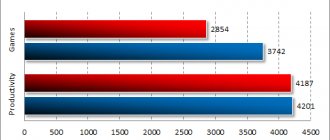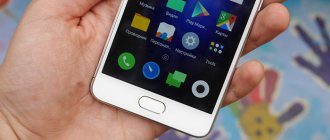In 2015, Lenovo introduced the long-playing P1 phablet, which then received several new modifications. Continuing the tradition, the company decided to create another such device, more modern and optimized. It was the Lenovo Vibe P2, introduced in the summer and going on sale in October 2021. The official cost of the device is $390.
The 2021 model has received a number of innovations and improvements compared to its predecessor. It has become more balanced and attractive, while maintaining (almost) all the advantages of P1. Let's try to find out what exactly has changed in the smartphone in the review.
Lenovo Vibe P2 specifications
For its price, the characteristics of the smartphone look excellent, as for a device from a brand officially sold in post-Soviet countries. This is not a Redmi Note 3 Pro or 4 for $200, but it’s not a Samsung C7 for $500 either.
Design, case materials, dimensions and weight
The material for the body of the device, as before, was aluminum. Almost the entire back panel is made of it. The device is assembled decently; you can hear some kind of creaking only if you deliberately try to twist the smartphone. Compared to its predecessor, Lenovo Vibe P2 has “lost weight”: its weight has decreased from 189 to 177 grams, and its thickness has decreased from 9.9 to 8.5 mm. The remaining dimensions remained the same: 15.3x7.6 cm.
The front panel of the smartphone is covered with glass with polished edges, smoothly turning into a chamfer on the side frame. Above the display is a standard set of speaker, camera and sensor window, below it is a fingerprint scanner built into an almost rectangular button.
The back of the smartphone is aluminum, only at the bottom and top there are two plastic covers for antennas. The camera and flash are located on the cover; there are no other elements (except for a small logo).
The side frame is pronounced, with shiny chamfers. On the right side are the volume control and power/lock keys.
On the left side there is a slot for cards, as well as a slider for switching the energy-saving mode (like the sound switch on the iPhone). Here lies one of the disadvantages of the new model: in the previous P1, the cards were placed under a removable cover at the top, and all the slots were separate, unlike the P2.
At the bottom end there is a MicroUSB port, on both sides of it there are grilles and plastic inserts.
The same inserts are at the top, with a headphone jack and a microphone hole for noise reduction/stereo sound recording located symmetrically between them.
CPU
The smartphone is equipped with SoC Snapdragon 625 - perhaps the best solution in the mid-class from Qualcomm. Of course, there are even more powerful 650/652, but they are built on a 28 nm process technology (625 has 14 nm). Due to the new SoC, the device demonstrates reduced power consumption.
8 Cortex A53 cores are the minimum set for a decent mid-level processor; in the Lenovo Vibe P2 they operate at a frequency of 2 GHz. Graphics processing is handled by the Adreno 506 GPU. This combination provides about 65 thousand points in AnTuTu, is gentle on the battery and, in general, is ideal for a smartphone in this category.
Memory
The RAM capacity of the international version of P2a42 is 3 GB; for China (where the company is rapidly losing share under the pressure of Oppo, Vivo, Huawei and Xiaomi) a more delicious version of P2c72 with 4 GB has been prepared. The system takes up a little more than 1 GB. The device has 32 or 64 GB of built-in memory, respectively, of which 25 or 56 are free. There is also a 4/32 GB model for the international market. The memory card slot is combined with the second SIM card slot (it was separate on the P1). OTG flash drives are supported.
Battery
The battery is a bright advantage of the device; its capacity reaches 5100 mAh. This is a lot, considering that the thickness of the smartphone is 8.5 mm (0.15 mm less than the Redmi 3 Pro with 4050 mAh). The combination of a large battery, an energy-efficient processor, the same display and a proprietary saving mode allows you to achieve excellent battery life.
You can squeeze up to 15 hours of active screen time out of your smartphone if you don’t let it go all day. And it’s not a fact that the smartphone will signal about discharge before you want to sleep. With moderate use (2 hours of screen time per day), you can count on up to 5 days without recharging, and if you put the device down and don’t touch it, even a week in standby mode doesn’t look fantastic. The adapter with the TurboPower function replenishes the charge to 100% in just over 2 hours.
Cameras
The smartphone has a 13 MP camera based on the Sony IMX258 matrix. This is a good, but not ideal matrix, previously used in Xiaomi Redmi Pro, Mi4C, Meizu M3E, Sony Xperia XA (front). During the day it is capable of taking good pictures, with decent detail and normal dynamic range. In the evening the result is more modest, noise and soap make themselves felt. In general, the camera is not the strong point of the Lenovo Vibe P2, although it cannot be called completely dull.
A 5 MP matrix from OmniVision is installed on the front; it copes with video calling and taking selfies, but does not deserve any special epithets. Front camera, like front camera. The device records video in FullHD, with a frequency of 30 FPS.
Screen
Lenovo Vibe P2, unlike its predecessor, received a display based on an AMOLED matrix (P1 had a traditional IPS). The resolution remains the same, 1920x1080 pixels, 401 PPI. The viewing angles are good, although the brightness is average (about 350 nits), but due to the peculiarities of the technology (the pixels themselves glow), the picture looks bright and juicy. There is practically no excessive acidity of the shades; the colors do not look completely unnatural, like in earlier generations of OLED.
The sensor is covered with tempered glass and has an oleophobic coating of slightly above average quality. Up to 10 simultaneous touches are supported.
Communications
Both SIM card slots are Nano format, the second is combined with the second SIM slot. The international version works on GSM, 3G and LTE networks of all European operators, but does not support CDMA. In the Chinese modification, Lenovo Vibe P2 works with CDMA, but may not work with all LTE networks.
The Wi-Fi wireless module works with both 2.4 and 5 GHz, supporting all current standards. The navigator is also universal – GPS/GLONASS/BeiDou. Satellites are located quickly on both cold and hot starts. It's nice to have NFC on board for contactless payment for purchases.
Sound
Despite the two grilles at the bottom, the Lenovo Vibe P2 only has one speaker. It is loud and sounds clear; it is very difficult to drown it out accidentally due to its convenient location. The sound in headphones is also good, but Hi-Fi, but the potential of MP3 320 kbps reveals. The smartphone also has a radio receiver.
operating system
The international version of Lenovo Vibe P2 is equipped with VibeUI firmware based on Android 6. The differences from stock Android cannot be called significant, for example, the curtain is identical to pure AOSP assemblies. The Chinese version has more differences. The OS runs smoothly, is stable, and has power saving features. The biggest drawback is the colors of the interface: it is not very optimized for OLED. In standard applications (contacts, dialer, settings) there is a lot of white, and this color neutralizes the advantage of AMOLED in the form of efficiency.
Design features and control elements
As soon as a person starts choosing a smartphone, he pays attention to how the phones look, and only then begins to understand their characteristics, nuances of operation and other little things. The smartphone in question is no exception. But it is worth saying that its appearance does not cause much enthusiasm. An ordinary, one might even say standard, design that does not catch the eye.
- This model is sold in two colors:
- Dark gray metallic;
- Gold cream metallic.
The colors are muted, somewhat worn out. But for an everyday phone it's a pretty good option. People who prefer brightness and originality will most likely pass by the smartphone in question precisely because of its more than modest design. Nevertheless, both colors have a right to exist, since they are in demand among a certain audience.
- The design is simple, one might even say, as simplified as possible:
- Monoblock non-separable type;
- Combined slot for SIM cards and memory cards. It is located on the left side surface.
In addition, the Lenovo P2 design includes the following parts:
- The switch lever is an atypical element that is used to switch the smartphone to power saving mode. It also displays the screen in black and white and performs many other functions that the user can become familiar with after purchasing a smartphone;
- There is a second microphone, which is located on the top end of the device;
- The body frame is made of steel. As for the back panel, it is also made of metal, only at the bottom and top it is supplemented with plastic inserts. They are here for a reason; there are antennas under them. As practice proves, antennas work much better under a plastic coating than under metal plates;
- There is a fingerprint sensor. It is built into the center key. This is convenient, but it is advisable to use this supplement if your hands are clean and dry.
As for the standard design parameters, first of all you should indicate the dimensions of this device. They are 153x76x8.3 mm. Despite this, the Lenovo smartphone cannot be called huge. It is quite well made to be convenient to use even despite its dimensions.
Our review of Lenovo Vibe P2
The Lenovo Vibe P2 review showed that the smartphone, if not perfect, is very good. This is a kind of golden mean for those who do not want to overpay for a flagship, but want to get a decent implementation of all the functionality. Even the disadvantages that have been identified are not critical.
Among the competitors of 2021, it is not very easy to find an analogue. Xiaomi Redmi Note 3 Pro is cheaper, but it has a slightly worse battery (with the same thickness), no NFC, a weaker camera, and a cheaper appearance. The Samsung A7-2016 offers a better camera and a thinner body, but its chipset is weaker and is built on a 28nm process, and the battery is significantly smaller. Asus ZenFone 3 ZC551KL has a slightly better camera, but it has a weaker chipset, and a smartphone with 3000 mAh is not suitable for a long-lasting solution. Thus, the Vibe P2 has no truly viable competitors.
Device display features
The Lenovo company has been on the market for quite a long time, but the attitude towards its smartphones is still ambiguous. Of course, we came across not the best devices, but the fact that this configuration is not one of those is for sure. This device has a good screen.
Now smartphones with large screens are considered fashionable, so 5.5 inches is just the golden mean for a modern phone. Here are just a small part of the screen characteristics that can indicate that the smartphone is really worthy:
- An AMOLED matrix is used;
- Supports FullHD;
- Automatic brightness adjustment.
In general, there is nothing special here, but considering how much the device in question costs, it is very difficult to find something similar with the same characteristics at a reasonable price. Especially if you want the manufacturer to be recognizable.
As for the screen's operation in the sun, as the photo shows, there are no problems with this. Of course, the brightness is a little lower, but considering that it is generally better not to take out many smartphone models on a sunny day, this is far from the worst option. In addition, there is a built-in function for automatically adjusting screen brightness. It is very convenient, especially when you often need to leave a dark room into bright light and back.
As for the screen brightness parameters, they are as follows:
- The maximum in automatic mode is 500 nits;
- The maximum in manual mode is 360 nits.
An oleophobic coating is used, so there are no fingerprints left on the screen. But the more you use your smartphone, the faster it wears off.
Software features
Reviewing video reviews of Lenovo P2, it is noticeable that special attention is often paid to the software. This is not surprising, since it depends on how the smartphone will work, and whether it will function at all. So, the base is Android 6.0.1, but on top of it is the Vibe UI shell (at least that's what it used to be called). It consists of various essential programs that make standard Android more interesting and unusual.
If desired, you can specify the applications that are most important to the user and get quick access to them. But that’s not all that pleases Lenovo smartphone owners. There are a number of features that can only be used by users of smartphones from the manufacturer in question:
- When working with Wi-Fi, the frequency at which this connection operates is shown;
- When a contact calls, you can set a full-screen photo for the call. And not only for incoming, but also for outgoing;
- You can set a schedule to automatically turn on and off your smartphone;
- There is a so-called Lenovo ID, which allows you to archive data in the cloud, synchronize devices, save passwords and perform a lot of other operations;
- Smart power manager;
- Many original and colorful themes not only for the screen, but also for interface elements;
- There is an additional option to use a safe zone;
- Smart Lock function.
If something is not clear, the package includes instructions that will explain in simple language how to work with the phone.
Hardware (processor, memory)
The smartphone is equipped with an energy-efficient chipset – SoC Qualcomm Snapdragon 625, with an integrated Adreno 506 graphics accelerator. The maximum frequency of 8 Cortex-A53 processor cores reaches 2 GHz. The amount of RAM is 4 GB. This is quite enough for the smooth operation of the interface and quick launch of applications for another couple of years.
The power of the Lenovo P2 hardware is not comparable to top-end smartphones, especially according to the results of testing using AnTuTu (about 65 thousand points). However, in everyday use this difference is not so noticeable: the device copes with any task, including running resource-intensive 3D games. It is also worth noting the lack of heating: even after an hour of intense gaming loads, the case remains barely warm and this device avoids throttling. The smartphone can easily run World of Tanks, Asphalt 8 at maximum settings and there were no freezes or stutters during the game.
The device comes with 32GB of internal memory. About 24 GB is available to the user, which in most cases is enough to install the necessary games, applications and store photos. In addition, it is possible to install an external MicroSD drive (instead of a second SIM) with a capacity of up to 128 GB.
Cameras
Many buyers are primarily interested in the features of the cameras installed on their smartphones to take photos and shoot videos. The Lenovo company does not use any special “bells and whistles” for its cameras, but makes them at the proper level.
For example, the front camera is five megapixel. It includes a standard set of functions, including programs for improving complexion, etc. The familiar interface has not changed, so it will be convenient for users to understand how everything works.
But it is worth noting the presence of a new Smart camera mode. Thanks to it, you can automatically select a composition, which is very convenient for a beginner who wants to make a beautiful SIM card, but does not know how. In general, the cameras in this device are as close in functionality as possible to conventional digital point-and-shoot cameras, which eliminates the need to buy additional equipment in order to take high-quality pictures.
The interface is Russian, which is quite convenient for those who do not understand English. But regarding the shortcomings, there are also many of them:
- Quite often the exposure in the photo is incorrect, which makes the pictures, to put it mildly, not very attractive;
- The pictures come out either very dark or light, etc.
In general, the camera is not the best, but if the buyer does not intend to use the phone as a camera, then there is nothing to worry about. But there are no such complaints about the video. You can record pictures in FullHD or 4K format. It turns out, of course, not like professional shooting, but the producers did not achieve this.
Calls, multimedia
You can install two SIM cards in the smartphone (both are in nano-SIM format), and instead of one of them you can put a microSD memory card.
The speaker has a fairly good volume reserve; the interlocutor's speech (at maximum volume level) can be heard in a noisy place without any problems; there were no noticeable distortions in the voice. The multimedia speaker is also quite loud, at maximum it sounds without rattling and even shows a faint hint of bass.
Battery performance
A detailed review of the Lenovo smartphone in question could only begin because of the battery that is used on this model. The fact is that although there are many devices on the market with similar parameters, this does not mean that they all work the same.
The charge drops the most when watching videos, so let's start testing the battery by seeing how it will withstand the test of watching movies at the highest screen brightness. So, as practice has shown, Lenovo P2 lost all its charge after 25 hours of continuous operation. This is more than worthy, one might even say, a record.
As for the mixed operating mode, when connecting Wi-Fi, etc., depending on the load, the device can be safely operated for three days or more. And if the owner of the device does not sit for days on end, stuck to the screen, then Lenovo P2 can work without recharging for about six days. In general, an ideal option for forgetting about recharging for at least a couple of days.
Now let's talk about how exactly the charging itself occurs, given that Lenovo said that this model supports fast charging. In practice, it turned out that it was necessary to charge in normal mode. Although this is not the biggest disadvantage, it is still unpleasant. Although this may be due to some special charger. But for some reason this does not work with standard charging.
As for the standard charging mode, you can get a full battery in four hours. And in order not to lose it, the side lever switches the device to maximum saving mode.
Applications
Lenovo Companion is a mobile troubleshooting tool. You can search for step-by-step instructions for your device (in written or video form), you can check for firmware updates (with backup enabled), and diagnose all of your phone's hardware (such as checking vibration or speakerphone).
SYNCit allows you to backup contacts, SMS and call history to Lenovo cloud. If you don't want to set up an account, you can backup to an SD card.
There is also an app called SHAREit. For the most part, it works as advertised for file sharing as long as there are Lenovo handsets on both ends. Other devices can expect varying degrees of success.
Google Play Music and FM Radio
Play Music works as a universal music player but is also a streaming application. Google boasts 50,000 tracks and if you're concerned about data usage, you can simply make your favorite albums available offline. However, if you prefer your own music library, then Play Music will help you load tracks from your computer or USB drive if you have one.
The FM radio is a nice touch. Of course, you can stream music using Play Music, but FM radio broadcasting is free and available in places that may not have a data connection. The Radio app can record radio broadcasts, but lacks RDS (a feature that displays station name and other information).
Connection
Lenovo P2 is available in a dual-SIM configuration in select markets. As mentioned, the downside is that it uses a hybrid tray, so you have to sacrifice one of the SIM cards to get the extra memory storage. LTE is also included, with speeds set to Cat.6 or 300 Mbps and 50 Mbps.
The P2 comes with dual-band Wi-Fi 802.11 a/b/g/n/ac support. Bluetooth 4.1 and NFC are available. There's also an FM radio on board, a rare sight. The microUSB 2.0 port supports USB-On-The-Go so you can connect flash drives and other USB accessories to it. It can't output video because it doesn't have MHL or SlimPort features.
